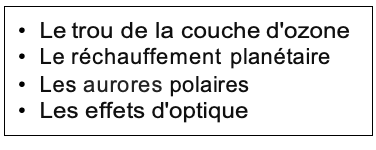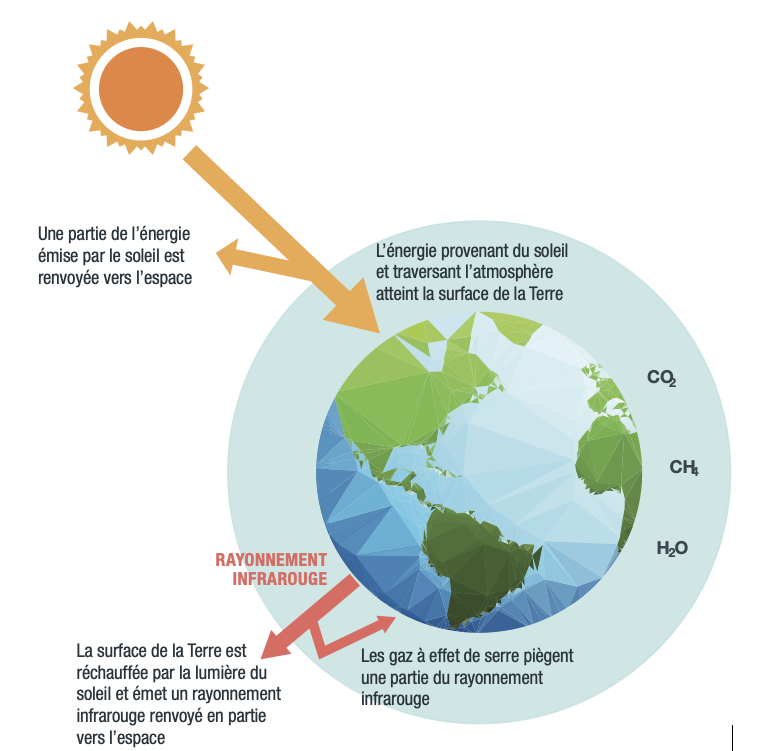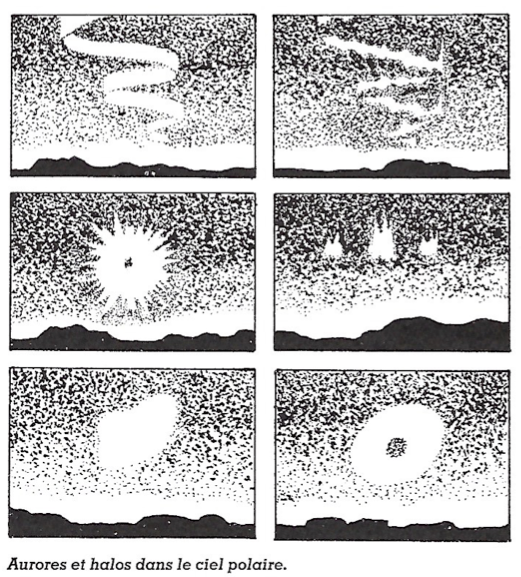Polar Encyclopædia
ANTARCTIC ATMOSPHERE

What a beautiful surprise to see, at random in the polar night skies, the fascinating moving lights of the polar auroras which blossom, undulate and fade in the firmament, to the rhythm of the flows of particles and magnetic puffs which come from the sun. Perhaps the members of the expedition will witness, on the Antarctic coasts, iridescent halos that make the sunlight explode, or some mirages that give birth to imaginary landscapes in the polar sky.
What you should know :
Have you ever heard of the ozone hole? This "hole" appears in the spring in the Antarctic atmospheric ozone. Ozone is a gas whose molecules are made up of 3 oxygen atoms. It is present in very small quantities in the upper layers of the atmosphere (stratosphere) and is distributed essentially between 10 and 20 km in altitude. If it were uniformly gathered at sea level, this gas would not form a layer greater than 3 mm. Even though it is very small, this quantity of ozone stops a part of the ultraviolet rays emitted by the sun, which are dangerous for living beings (alteration of the genetic code, skin cancers, cataracts...). Unfortunately, from the 1980s to the 1990s, the stratospheric ozone level decreased by half over Antarctica. This disappearance was due to the release of gases called CFCs (Chlorofluorocarbons) contained in aerosol cans and refrigerators, which were then banned by the Montreal Protocol in 1987. These CFCs, which are totally harmless at ground level, rise into the stratosphere, are distributed around the Earth and are destroyed by ultraviolet light, releasing active chlorine. A complex succession of chemical reactions leads to the destruction of ozone by chlorine. But why over Antarctica? Because, during the long winter night, the polar air is isolated and deprived of an equatorial ozone supply; moreover, the intense cold at altitude (-90°C) favours the release of chlorine at the level of the ice crystals present in the Antarctic winter sky (stratospheric clouds). Spring light triggers the destruction of polar ozone by chlorine. Special lasers called Lidars, allow to measure the ozone over Adelie Land. The ozone loss over Antarctica reached an area of 24 million km2 in 2014, the record dating from 2000 with 29.9 million km2. Currently, the hole in the ozone layer is smaller than during the period 1998-2006. In 2022, it was 23,2 millions of km2.

Figure 1: Diagram of the greenhouse effect © Office for Climate Education
The greenhouse effect is due to the presence of certain gases (carbon dioxide, methane, nitrogen oxide, water vapor...) in the atmosphere. This effect is totally natural and allows us to record on our Earth an average temperature of +15°C, but which would be -18°C without greenhouse effect. However, through our human activities, we are constantly adding greenhouse gases to the atmosphere and have thus, since the industrial revolution, increased the temperature of our planet by +1.2°C. This greenhouse effect is linked to the absorption of infrared rays (linked to the temperature of a body, here the surface of the Earth heated by the sun) by these gases and the re-emission into the atmosphere. We can therefore imagine that the atmosphere plays the role of a blanket that would thicken around the Earth and give it more heat. This increase in temperature leads to a partial melting of ice, an increase in sea level, an amplification of the water cycle and extreme events (floods, droughts, etc.). The future of our climate and of the polar regions now depends on the measures we take (or not) to change these emissions, which are becoming more and more important every year.

Mirages do not only exist in hot deserts! Some particular phenomena are also born in the Antarctic atmosphere. In very cold conditions, the temperature inversion near the ground deflects the path of the light rays which thus form mirages above the horizon. Ice crystals suspended in the air and clouds also give rise to magnificent plays of light: iridescent halos around the sun (parhelion, and even "false suns"). Identical phenomena can occur around the moon. But the spectacle of Antarctic nights is, par excellence, the appearance of a southern lights. With no connection to the birth of daylight, these changing lights that illuminate the night sky of the high latitudes originate from the electrified particles ejected into space by the sun (solar wind arriving at the level of the Earth, at about 500 km/s) and which, guided into the southern and northern upper atmosphere by the Earth's magnetic field, ionize the air in their path, between 100 and 1000 km in altitude (the colors of the light emitted depend on the ionized atoms, for example red and green for oxygen). In the upper atmosphere, these electrified particles that surround our planet guide the radio electromagnetic waves and allow telecommunications, which the auroral magnetic storms can greatly disrupt.
Suggested activities
The Antarctic atmosphere
- How does the greenhouse effect affect Antarctica?
- Can you imagine an experiment with some salad bowls and desk lamps to recreate the greenhouse effect?
- Why is Antarctica the area of the globe where the ozone layer is the most fragile?
For more details
Books :
- Atmosphère – D. Hauglustaine, J. Jouzel, V. Masson-Delmotte
- Atmosphère, océan et climat – R. Delmas, S. Chauzy, JM. Verstraete, H. Ferré
Miscellaneous :
- Animation évolution du trou de la couche d’ozone, ici
- Ressources pédagogiques de l’Office for Climate Education : oce.global
Support the project with a donation
The Polar POD expedition is one of the stamp of the pioners, a human adventure coupled with a technological challenge, an oceanographic exploration never before carried out which will mark a milestone in the discovery of the oceans.
Thank you for your support !